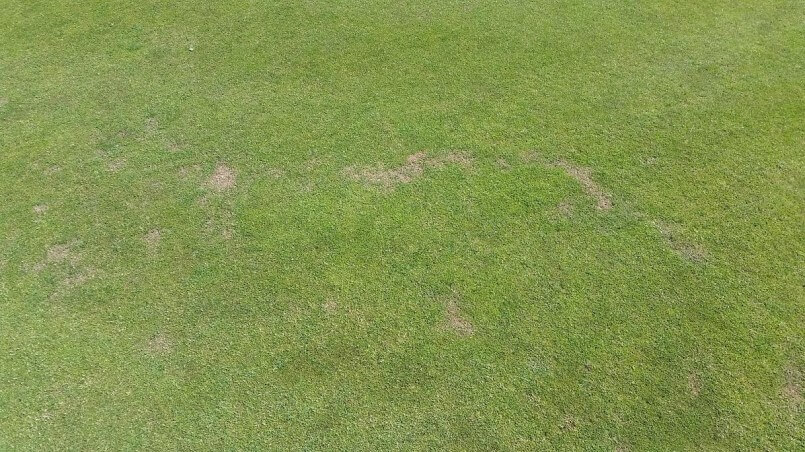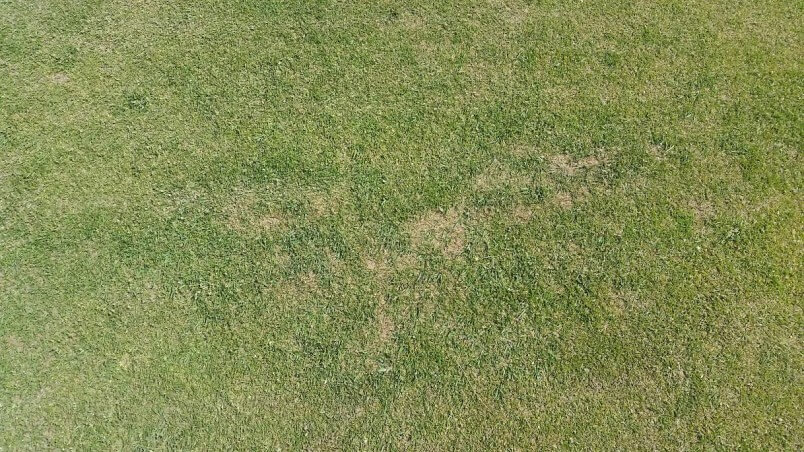
Sun, Sun, Sun!
I always manage to start monthly updates by talking about the weather, but this time it is well justified because apart from a recent two-day blip, it has been absolutely exceptional recently. The fairways look fantastic when they are burned out and have been freshly polished with the mowers, and they must be great fun to play from. For those of you who haven’t had the pleasure of playing out here over the last few weeks, I took a couple of photos for you last week before the rain (which arrived on Monday, 15th May) and dampened things down just a bit.

The Downside to the Sun, Sun, Sun!
A frazzled golf course may be attractive to look at and great fun to play, but these conditions do provide us greenkeepers with some headaches. Some of the less mature green surrounds that were initially turfed straight onto pure sand have started to de-stabilise a bit. So, we made the decision to stop cutting them until the rain inevitably returned. Now that we have had a bit of moisture, we will re-turf the worst patches, after integrating some good-quality topsoil into the rootzone.

The other thing we have been struggling with recently is dry patches and fairy rings in the greens. Fairy ring is an extremely trivial name for what is a pretty insidious malaise. It can cause major damage to fine turf if allowed to remain unchecked. Contrary to popular belief, this issue is not caused by fairies dancing innocently round in circles wearing out the grass, but rather by the actions of fungal bacteria which are naturally present in the soil. These bacteria multiply rapidly and expand outwards from a central point, colonising rootzone space as they go. As they go about their work, they secrete a waxy material, which is deposited in the rootzone and can dry out and form an impenetrable barrier if regular rain or irrigation water is not forthcoming over an extended period of time. Once this barrier has been established, it becomes extremely difficult to break down again with subsequent applications of water. It can take large volumes of rain for moisture levels throughout the rootzone to be forced back to optimum levels. The reason that fairy rings appear as a ring is because the advancing army of fungal bacteria operating at the front face of the attack are secreting waxy deposits as they march. They naturally go in all directions at approximately the same speed, forming a roughly circular hydrophobic barrier in the rootzone.
Obviously, the worst aspect of fairy ring attacks is that you only see the effects of them once the damage has already been done, i.e. once the soil has already gone hydrophobic and once the affected grass is already suffering from severe drought stress. Once the fairy ring has become apparent, the priority must be to get the roots of the affected grass wet again. This is far from easy as the waxy deposit will have gone solid and water will run off it in just the same way as it will run off the grease on your dinner plate if you try to wash your dishes without using washing-up liquid. The absolute worst thing a greenkeeper can do in these circumstances is to look at the weather forecast and see that there is 20-30mm of rain due in the next week and just assume that this will fix the issue— because it won’t. The rainwater will merely run off the affected areas into the unaffected areas of the rootzone, further accentuating the difference between the turf that has sufficient moisture and the turf that doesn’t. The sun will then come back out and the affected areas will dry out again immediately as any water that has managed to penetrate a couple of millimetres into the soil quickly evaporates while the healthy areas of the green, which have now been fully soaked through, flourish, blissfully unaware of the trauma that is going on mere inches away. Eventually, the continuity of the surface will be compromised and putts will begin to meander all over the place.
What we did to combat this attack on our greens was to verticut and mini-tine the greens, creating a grid pattern of grooves and holes for water to settle into— giving it the best chance to soak into the areas of the rootzone that we wanted to treat. We then sprayed wetting agent onto the surface of the green and watered that in heavily, as the wetting agent has the same effect on the wax in the rootzone as the washing-up liquid has on the dinner plate I mentioned earlier (as long as you can wash it in with enough water to let it do its job, that is).
Finally, we also sprayed a fungicide which we know has a controlling effect on the fungal bacteria that causes this damage. All this work sets things up nicely for the rootzones to make the absolute maximum use of the heavy rain that inevitably heralded the end of this particularly dry spell. We gave ourselves the maximum opportunity to get the greens back to a starting point where all of our rootzones are now filled to field capacity and are equally and uniformly ready to accept water from both sky and sprinkler over the weeks and months of Summer still to come. In my previous life as Head Greenkeeper at Machrie (working with no irrigation at all), I learned to take dry patch and fairy ring attacks very seriously as I had no mechanical tools at my disposal to help me to re-wet the rootzone. This experience has stood me in good stead. It was very easy to lose a whole season there when the weather stayed dry through April and into May, as the affected areas would stay dry right into the next Winter. Now that I have all the available tools at hand, and I also know how serious the issue can become, it would be unprofessional of me not to try everything I could to resolve the issue as soon as I possibly could, and this is what we have done.


It has been widely accepted in the Greenkeeping circles for years that rootzones made up of medium sand are especially susceptible to attacks from dry patch and fairy rings, and I think there may be at least a couple of reasons for this. Obviously, these type of rootzones retain less moisture and are more prone to remaining dry over a long period of time, allowing the waxy material secreted by the fungal bacteria to go solid and form a barrier in the first instance. Medium sandy soils are also likely to be more deficient in the bacteria and organisms that would normally act as predators to these fungal bacteria— therefore their relentless march towards domination of the whole world underneath the green remains relatively unchecked. So, now that we have had an attack from these colonies of bacteria and we know that our greens may be prone to being compromised by their activities again in the future, what should we do to minimise the impact from this pest? Firstly, we should keep adding beneficial myccorhizal bacteria to the soil and continue to create an environment where they can multiply and flourish, and then hopefully tackle the bad guys in a big unseen battle for rootzone supremacy. We should keep our eye on moisture levels early in the season and avoid allowing the greens to dry out even when air and soil temperatures are low. And, I suppose we should probably consider applying a preventative fungicide once temperatures are elevated sufficiently to provide conditions that suit the pathogen. I always hate applying preventative sprays because it seems like such a waste of money, but I guess in instances like this, I’ll never know just how bad the greens could have been if I had only done nothing at all!
A Lull in the Competition Schedule
May and early June is a quiet time for competitions at Machrihanish Dunes, with just the monthly medals to look forward to. The Campbeltown Open (June 24th/25th) will be upon us before we know it. If you haven’t got your name down yet for this gala golf weekend, then I would say it is high time you gave Lorna a phone at the Golf House (01586810058) so that she can twist your arm to enter!
My sources tell me that the good weather is due for an imminent return following last week’s temporary blip, so I look forward to seeing you all out on the links over the next few weeks. Enjoy your golf!

